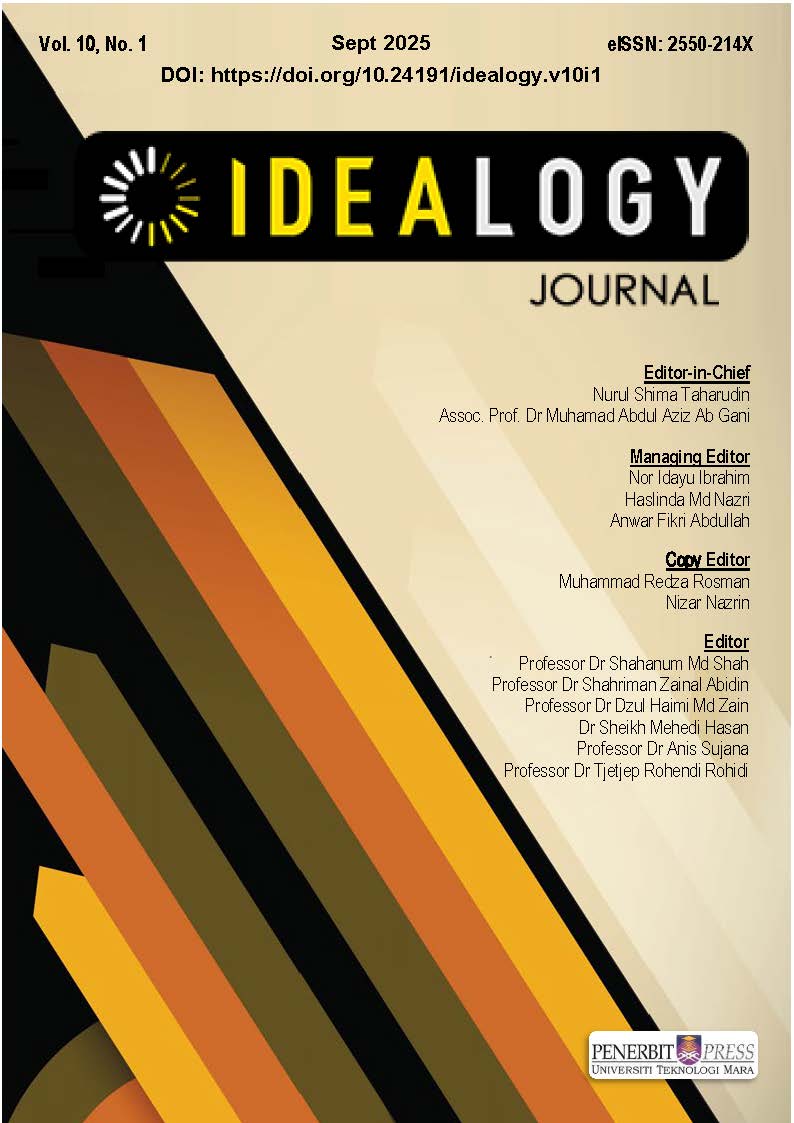Pilot Study on Integrating YanZhao Cultural Elements into Wayfinding Signage at Hebei Garden Expo Park
DOI:
https://doi.org/10.24191/idealogy.v10i1.598Keywords:
YanZhao cultural,, wayfinding signage, pilot study,, Integration, Hebei Garden Expo ParkAbstract
This study evaluates the feasibility of integrating YanZhao cultural elements into wayfinding signage at Hebei Garden Expo Park. Through a pilot study, initial feedback from visitors was collected to assess the effectiveness and appeal of culturally integrated signage. The findings from this pilot study were used to refine the interview questions and research methodology for the main study. This research aims to enhance visitor experience, promote regional culture, and improve navigation efficiency by incorporating YanZhao cultural elements into wayfinding signage.
Keywords: YanZhao cultural, Way Finding Signage, Pilot Study, Integration,Hebei Garden Expo Park
References
Calori, C., & Vanden-Eynden, D. (2015). Signage and wayfinding design: a complete guide to creating environmental graphic design systems. John Wiley & Sons.
Eco, U. (1979). A theory of semiotics (Vol. 217). Indiana University Press.
Ge, Y. Y. (2013). Analysis of urban exhibition Garden design highlighting regional characteristics -- Yanzhao Garden design of Hebei Garden Expo Garden in 2012. Hebei Forestry Science and Technology(2), 67-69. https://doi.org/10.16449/j.cnki.issn1002-3356.2013.02.006.
Iftikhar, H., Asghar, S., & Luximon, Y. (2021). A cross-cultural investigation of design and visual preference of signage information from Hong Kong and Pakistan [Article]. Journal of Navigation, 74(2), 360-378. https://doi.org/10.1017/S0373463320000521
Li, C., & Shi, L. (2020). The importance of electronic navigation systems in garden construction——a case study of the Cangzhou Garden in Hebei Province Garden Expo. Flowers(4), 70-71. https://doi.org/CNKI:SUN:HUHU.0.2020-04-045.
Liu, J., & Bao, Y. (2008). The Major Progress and Thinking about the YanZhao Cultural Studies for 30 Years三十年来燕赵文化研究的主要进展与思考. Journal of Hebei University(Philosophy and Social Science)(06), 93-98. https://doi.org/CNKI:SUN:HBDS.0.2008-06-017.
Lynch, K. (1984). The image of the city. Springer.
Ma, C. (2013). The Traditional Connotation and the Present Interpretation of Yanzhao Culture. Journal of Hebei University(Philosophy and Social Science)(1), 153-156. https://doi.org/CNKI:SUN:HBDS.0.2013-01-031
Montello, D. R., & Sas, C. (2006). Human factors of wayfinding in navigation.
Ryan, D. J., & Hill, K. M. (2022). Public perceptions on the role of wayfinding in the promotion of recreational walking routes in greenspace—Cross-sectional survey. Wellbeing, Space and Society, 3, 100111.
Shamsuddin, N. A. A., Din, S. C., Saruwono, M., & Ahmad, M. (2022). A Review on Wayfinding Information in Complex Environment. Environment-Behaviour Proceedings Journal, 7(SI7), 129-134.
Sjolund, L. A., Kelly, J. W., & McNamara, T. P. (2018). Optimal combination of environmental cues and path integration during navigation. Memory & Cognition, 46, 89-99.
Symonds, P., Brown, D. H., & Lo Iacono, V. (2017). Exploring an absent presence: Wayfinding as an embodied sociocultural experience. Sociological Research Online, 22(1), 48-67.
Vasileiou, K., Barnett, J., Thorpe, S., & Young, T. (2018). Characterising and justifying sample size sufficiency in interview-based studies: systematic analysis of qualitative health research over a 15-year period. BMC medical research methodology, 18, 1-18.
Wang, G. (2021). Wudang Mountain Scenic Spot Based on Taoist Cultural Background Guide system design research [Master, Hubei Institute of Fine Arts].
Wu, M., & Yu, H. (2023). Hebei: Retaining the "roots" of Yanzhao Culture. The People’s Congress of China(12), 41-42. https://doi.org/CNKI:SUN:ZGRE.0.2023-12-016.
Zong, j. (2013). Hebei Garden Expo Lamps Design河北省园博园灯具设计研究 [Master, Hebei University of Science and Technology].
Published
Issue
Section
License
Copyright (c) 2025 UiTM Press

This work is licensed under a Creative Commons Attribution-NonCommercial-NoDerivatives 4.0 International License.
UiTM Press (the Publisher) has agreed to publish the undersigned author’s paper in Idealogy Journal. The agreement is contingent upon the fulfilment of a number of requirements listed below.
1. The undersigned author warrants that the paper entitled below is original, that it is not in any way libellous or unlawful in Malaysia, that it does not infringe any copyright or other proprietary right. The undersigned hereby represents and warrants that he/she is the author of the paper, except for material that is clearly identified as to its original source, with permission notices from the copyright owners where required. The undersigned represents that he/she has the power and authority to sign and execute this agreement.
2. The undersigned author warrants that the paper entitled below has not been published elsewhere, and also it will not be submitted anywhere else for publication prior to acceptance/rejection by this Journal.
3. By submitting the paper entitled below, the undersigned author agrees to transfer the rights to publish and distribute the paper in an international e-journal (entitled above) to Publisher.
4. The undersigned author agrees to make a reasonable effort to conform to Publisher's submission guidelines and to liaise with the editor to ensure that the requirements of these guidelines are met to a reasonable degree.
5. The corresponding author signs for and accepts responsibility for releasing this material on behalf of any and all coauthors. This agreement is to be signed by at least one of the authors who has obtained the assent of the co-author(s) where applicable. After submission of this agreement signed by the corresponding author, changes of authorship or in the order of the authors listed will not be accepted.


